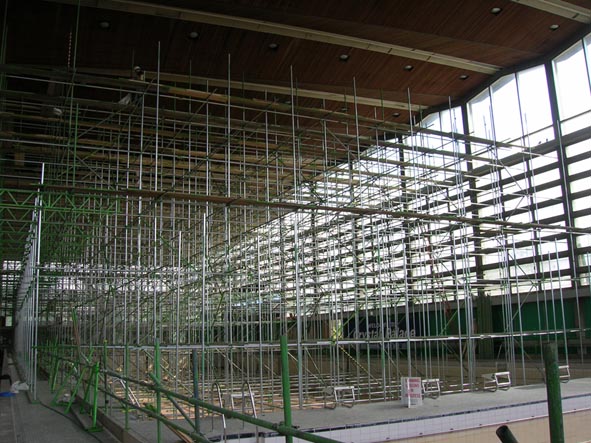
(E6) National Sports Centre - Refurbisment Site Visit May 2008: a picture record
by Ray Sacks Crystal Palace Campaign (visit 2 May 2008)
From the outside the visible scaffolding doesn't prepare you for the forest of poles filling the NSC. Most of the asbestos removal is on the main concourse area's ceiling, where it was sprayed on (as a floc) to a thickness of about 50 mm. It was probably mainly intended to be an acoustic absorbent, so a platform was built just below that level to accommodate the people traffic needed to carry out the job. The platform extends under the entire ceiling and has attracted the nickname the 'dance floor'. In addition asbestos was found in the pipe lagging in the boiler area and in the roof voids above the arena and pool area. A fll Class 3 survey was done throughout the buliding since the earlier surveys showed significant amounts of asbestos in many parts of the building.
This picture of the swimming pool area gives an idea of what the steel forest of scaffolding is like.

The main contractors on site are SPIE-Matthew Hall and EMS Vectra N. Jones(EMS Services Ltd) - see notes at the end - but I was taken around the site by Bob Myers who is the Senior Project Enginer for the LDA. He steered me carefully through the action plans and literally through the NSC maze of a building including many areas not usually seen by the public.
Although the original reason for concern was the aging plant, principally the boilers and pool filtration system, the presence of asbestos added to the difficulties. In fact, in terms of construction logistics it is the most complicated problem to deal with because of the severely hazardous nature of asbestos. The asbestos was stabilised and the sprayed-on area was divided into four sections. These zones, beneath the ceiling were sealed off with large, double skinned tent-like walls inside of which a slight negative pressure was mainatained to prevent air leaks outward from blowing asbestos into the general area. The asbestos within the tent is treated to minimise dust formation and it is then meticulousy removed by mechanical means. The material is then bagged in approximately 20kg lots and removed from the tented area having been sealed into a second bag.
|
 |
Vacuuming up some remnant dust inside the tented area. |
Carrying double-bagged asbestos waste to the hoist to be lowered to ground level. |
Air samples are taken continuously at strategic points around the building interior but, even though it showed clear, we had to wear masks around the outside of the tented area. Each sample is a filtered batch of about 4800 litres of air. The filters are scrutinised under a microscope and the number of particles counted. The working suits are sealed with the workers breathing through a very fine filter. The suits are disposed of as asbestos contaminated waste after each shift.
 |
 |
Some of the remaining areas to be cleared. |
Bob Myers (on the left) and some of the team. |
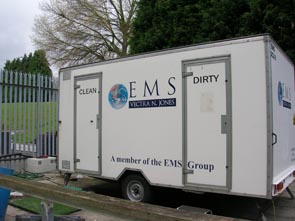 |
The asbestos operation and the meticulous care needed to ensure the safe removal of this highly toxic substance are no doubt hindering the rapid return of the building to its normal use. However, the staff, visitors, participants and spectators can be confident that they can carry on using the facilities provided for the next, say, ten years without being concerned that there is a danger from the left-over practices of the 1960s. |
| Clothing cleanliness control | Below is the "safety route" through the centre of the scaffolding. It could be used in emergencies for rapid evacuation of the building or for allowing rapid medical/help access in the case of illness or injury. |
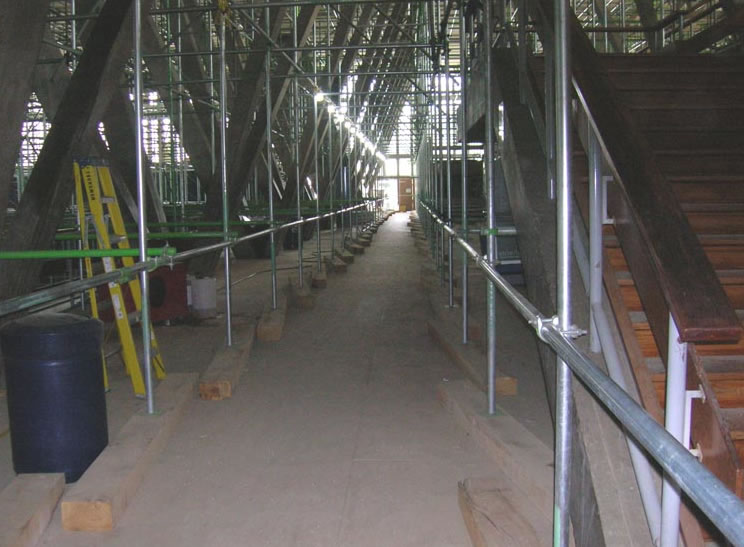
Changing rooms being gutted
(clockwise from top left) - Tiles being removed, sewage pipes, showers, loos.
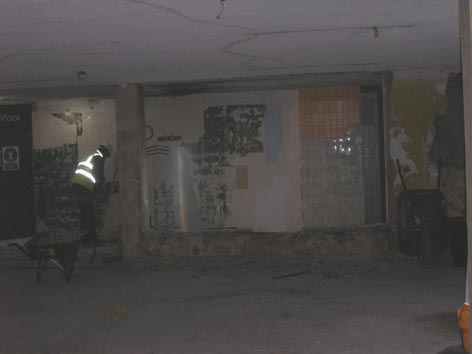 |
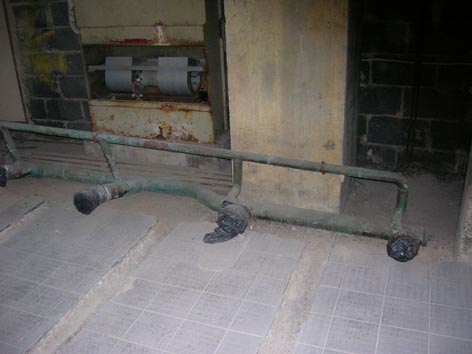 |
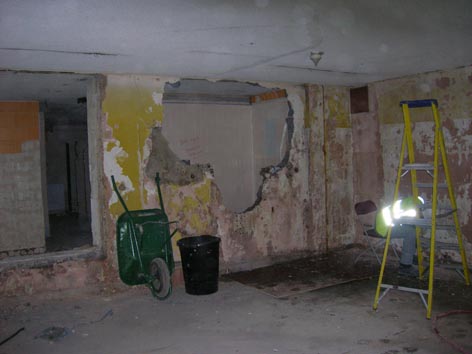 |
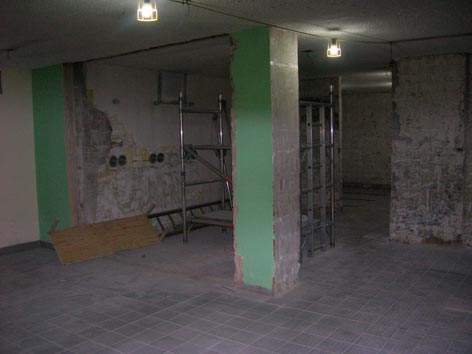 |
The State of the Copper Roof Covering
 |
 |
Note the fire extinguishers on the roof! There is a lot of wood (which could clearly be a fire fuel) in the roof construction under the copper. Nevertheless, the logistics of having the fire extinguishers on the roof of a building seems a bit strange also bearing in mind that access to the outside of the roof is rather restricted. Quantities of asbestos were found in all roof voids, necessitating a complete clean under controlled conditions - by tenting an area and cleaning under negative pressure. |
|
Boiler Room, Air Handling and Pool Filtration
Oil tank removed - cutting it up was the only satisfactory method |
The two main boilers (there is also a small third boiler)- some piping removed and asbestos lagging removed - currently it is being decided if repair or replacement is the right policy |
Control panel - to be repalacd |
Air moving fans - note silver tape (actually aluminium foil) covering asbestos gaskets |
Bronze valve completely blocked with various deposits including iron compounds - was once a check valve |
Pool filtration - piping needs refurbishment, filter material may need changing |
Lighting and other spaces
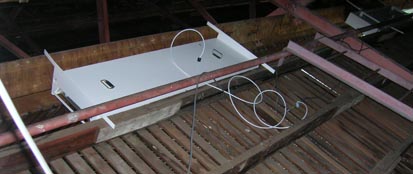 |
New lighting (the old is well beyond repair!) as seen from behind in the roof space (now clear of asbestos) - test unit to decide on suitable model
|
There are many other areas in the NSC which will be receiving attention - some require serious redecoration. Weightlifting area floors are fairly aweful, whereas the dance floor area has great potential which could be realised quite simply - sand and seal the excellent wooden floor. It may not always be desireable, or necessary, to pecisely match what is there from before. For example a little lightness in the corridors connecting rooms wth a range of functions is highly desirable. The walls of the corridors are currently painted dark blue. A coat of white, or something close to it, will make the areas brighter, more pleasant, easier to see your way around and generally safer. Also 2 cm extra will now truly make Crystal Palace pool the only Olympic standard pool in London.
In summary, it was great to see the work progressing well but it is important for those making the basic refurbishment decisions not to be always tied by practices of the 1960s.
SPIE-Matthew Hall (Main contractor)
Matthew Hall was founded in 1848 and became part of AMEC in 1988 as the latters Building and Facilities Services (BFS) division. They have more than 2300 employees in the UK and SPIE, who acquired Matthew Hall in Sptember 2007, have 23000 employees around the world. The group's turnover is just under €3billion.
EMS Vectra N. Jones(EMS Services Ltd) (Asbestos emoval experts)
Is a relatively small company with from 21 to 50 emplyees (in total) and specialises in asbestos removal, surveys and testing. "EMS Vectra N Jones are licensed to remove all types of asbestos. Our performance is continuously measured and monitored in accordance with our safety management systems and our ISO 9001 accreditation."
ASBESTOS
What is asbestos? - Information from Fibre Tech Services Litd.
Asbestos is a naturally occurring mineral, mined in Australia, Canada and South Africa during the 20th century. Its heat and sound resistant properties made it ideal for use in the manufacture of a wide range of products from pipe insulation, flooring materials, cement roofing and insulatory coatings to toilet cisterns, artex wall coatings and its wide range of use has resulted in asbestos now being present in some form in all but the newest of premises - its use was only completely prohibited in 1999.
The need for asbestos removal.
Asbestos is a Class One carcinogen but is only dangerous when the microscopic fibres are released into the air and breathed in. There is usually a long delay between the first exposure to asbestos dust and the onset of disease. This can be between 15 and 60 years, with the majority of people dying from asbestos related diseases now being exposed during the 50s and 60s.
Asbestos-related diseases, such as mesothelioma, asbestosis and lung cancer, currently kill over 3500 people each year in the UK. This figure is expected to rise to in excess of 10,000 per annum over the next ten years.
The danger from asbestos arises when the material is damaged or moved. Asbestos fibres may be released and breathed in, settling in the lungs of maintenance workers, plumbers, builders or whoever is in the area.
It is therefore vitally important to be aware of the location of asbestos containing materials within the workplace so that the potential of disturbance and fibre release can be prevented.
12/05/08 Last updated 13/05/08(spelling etc.)